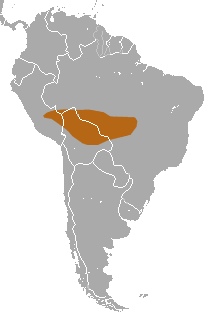| Bishop's slender opossum [1] | |
|---|---|
 | |
| Bishop's slender opossum climbing across a branch | |
| Scientific classification | |
| Kingdom: | Animalia |
| Phylum: | Chordata |
| Class: | Mammalia |
| Infraclass: | Marsupialia |
| Order: | Didelphimorphia |
| Family: | Didelphidae |
| Genus: | Marmosops |
| Species: | M. bishopi |
| Binomial name | |
| Marmosops bishopi Pine, 1981 [3] | |
 | |
| Bishop's slender opossum range | |
| Synonyms | |
Marmosa parvidens bishopiPine, 1981 | |
Bishop's slender opossum (Marmosops bishopi) is a small, arboreal marsupial in the opossum family native to Brazil, Peru, and Bolivia. [1] It somewhat resembles a placental rat or shrew.
